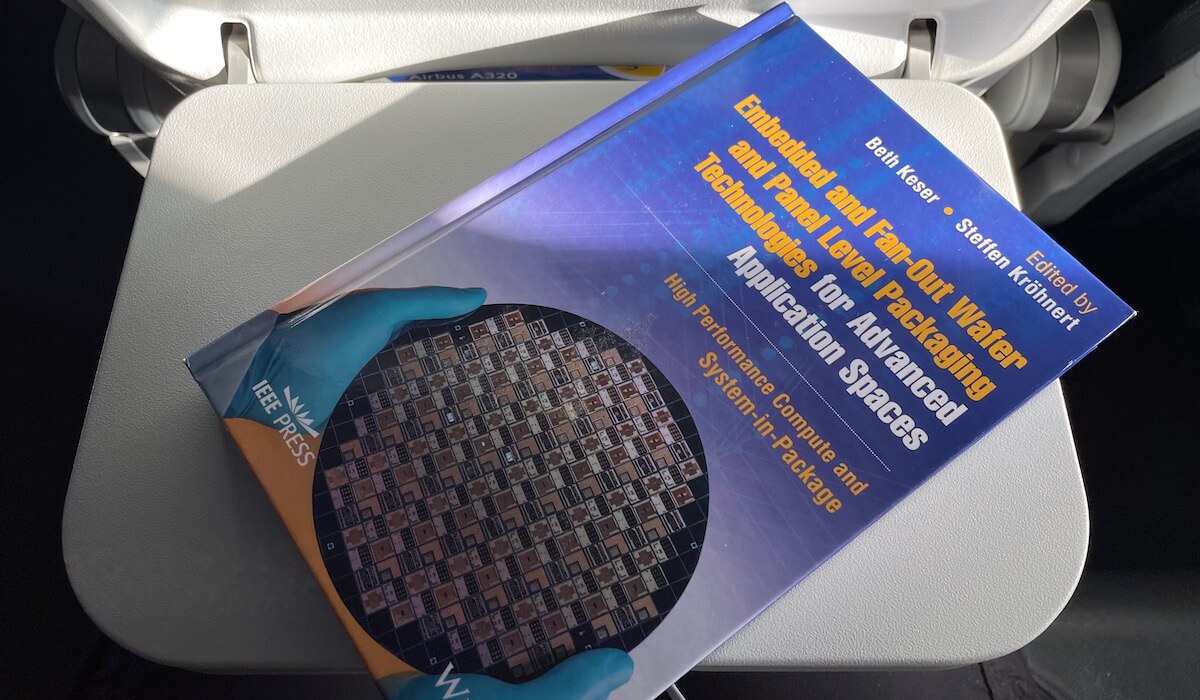I have a confession to make. Last March – we’re talking March of 2023 at IMAPS DPC – Beth Keser, IMAPS president, presented me with a signed copy of the book she co-edited with Steffen Khröhnert – Embedded and Fan-Out Wafer and Panel Level Packaging Technologies for Advanced Application Spaces: High-Performance Compute and System-in-Package, and I promised I’d review it. It’s essentially the sequel to Advances in Embedded and Fan-out Wafer-Level Packaging, which I reviewed after the duo published it in 2019.
Yet here we are, more than six months later, and I’ve been carrying it around with me for months without finding the time to crack the cover. But I finally started reading it on the flight to the IMAPS Symposium in Boston in October, where I had the opportunity to interview her about it for a podcast episode. Now, I’m Munich-bound for SEMICON Europa, the podcast dropped last week (full episode below), and at long last, I’m putting pen to paper to talk about this book.
A Trip Down Fan-0ut Packaging Memory Lane
As I began reading the first chapter by Yole Développment, it was a trip down memory lane, as I first got into this industry in 2005, and remember the announcements of all these technologies – redistributed chip package (RCP), embedded wafer level ball grid array (eWLB), M-Series, integrated fan-out (InFO) – you name the acronym and it’s in there. For newcomers to the industry, this chapter provides a detailed history of wafer-level packaging.
Because 3D InCites was mainly focused on 3D IC technologies at the time, I remember well how all these FO advancements provided a more cost-effective solution for performance gains and subsequently pushed out the commercialization of TSVs and 3D stacking.
In addition to a history lesson, Yole’s chapter offers a market analysis – a snapshot in time, really – of what was driving the semiconductor market in 2021, in the midst of COVID-19, the chip shortage, and the US sanctions against China. They talk about Amkor’s SLIM and SWIFT, and the Nanium acquisition, and they even mention SLIM, the fan-out technology that didn’t make it.
What’s New in Fan-Out?
Rather than a second edition, I call this book a sequel because the book picks up where the first one left off. There are new chapters by those who contributed to the first book, providing technology updates. And there are completely new chapters by companies who’ve entered into the FO space.
For example, in the first book, Deca was still Deca Technologies, before it divested its manufacturing facility and reorganized as a technology IP company. In the first book, they write about M-Series. In this one, the focus is on Adaptive Patterning. Fraunhofer IZM is also back, this time with a chapter on its panel-level packaging consortium.
Another useful addition to this book is the chapter on cost analysis by Amy Palesko Lujan, of Savansys Solutions. In it, she cost compares FOWLP with flip chip, wire-bond, and other legacy approaches, so that readers can decide for themselves whether FOWLP is suited to their application.
Because TSMC was in the throes of commercializing InFO when the first book was being written in 2016/2017, they didn’t participate. But they play a starring role in the sequel, with TWO chapters dedicated to low-density and high-density InFO, as well as its 3DFabric product portfolio.
Additionally, to explain the difference and draw comparisons to FO technology, the editors included chapters on embedded chip technologies. AT&S authored a chapter about die integration on advanced substrates, including embedded and cavities.
Subu Iyer, of The UCLA CHIPS program, contributed a chapter on flexible hybrid electronics as a future trend. And Georgia Tech wraps things up with a chapter on polylithic ICs using 2.5D and 3D heterogeneous integration, focusing on electrical and thermal design.
While this surely isn’t a beach read, Advanced Fanout for High-Density Packaging is a must-add to your wafer-level packaging reading list and your resource library. Find it here.
Listen below to hear Beth Keser talk about the journey of writing both these books.




















